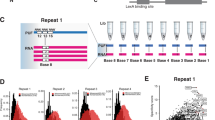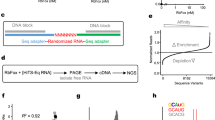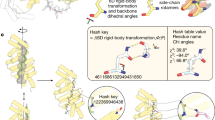Abstract
The design of proteins that can bind any RNA sequence of interest has many potential biological and medical applications. Here we have expanded the recognition of Pumilio and FBF homology protein (PUF) repeats beyond adenine, guanine and uracil and evolved them to specifically bind cytosine. These repeat sequences can be used to create PUF domains capable of selectively binding RNA targets of diverse sequence and structure.
This is a preview of subscription content, access via your institution
Access options
Subscribe to this journal
Receive 12 print issues and online access
$259.00 per year
only $21.58 per issue
Buy this article
- Purchase on Springer Link
- Instant access to full article PDF
Prices may be subject to local taxes which are calculated during checkout


Similar content being viewed by others
References
Glisovic, T., Bachorik, J.L., Yong, J. & Dreyfuss, G. FEBS Lett. 582, 1977–1986 (2008).
St. Johnston, D. Nat. Rev. Mol. Cell Biol. 6, 363–375 (2005).
Auweter, S.D., Oberstrass, F.C. & Allain, F.H. Nucleic Acids Res. 34, 4943–4959 (2006).
Lunde, B.M., Moore, C. & Varani, G. Nat. Rev. Mol. Cell Biol. 8, 479–490 (2007).
Carthew, R.W. & Sontheimer, E.J. Cell 136, 642–655 (2009).
Quenault, T., Lithgow, T. & Traven, A. Trends Cell Biol. 21, 104–112 (2011).
Wang, X., McLachlan, J., Zamore, P.D. & Hall, T.M. Cell 110, 501–512 (2002).
Wang, X., Zamore, P.D. & Hall, T.M. Mol. Cell 7, 855–865 (2001).
Edwards, T.A., Pyle, S.E., Wharton, R.P. & Aggarwal, A.K. Cell 105, 281–289 (2001).
Zamore, P.D., Williamson, J.R. & Lehmann, R. RNA 3, 1421–1433 (1997).
Cheong, C.G. & Hall, T.M. Proc. Natl. Acad. Sci. USA 103, 13635–13639 (2006).
Wang, Y., Cheong, C.G., Hall, T.M. & Wang, Z. Nat. Methods 6, 825–830 (2009).
Tilsner, J. et al. Plant J. 57, 758–770 (2009).
Ozawa, T., Natori, Y., Sato, M. & Umezawa, Y. Nat. Methods 4, 413–419 (2007).
SenGupta, D.J. et al. Proc. Natl. Acad. Sci. USA 93, 8496–8501 (1996).
Hook, B., Bernstein, D., Zhang, B. & Wickens, M. RNA 11, 227–233 (2005).
Wang, Y., Opperman, L., Wickens, M. & Hall, T.M. Proc. Natl. Acad. Sci. USA 106, 20186–20191 (2009).
Gupta, Y.K., Nair, D.T., Wharton, R.P. & Aggarwal, A.K. Structure 16, 549–557 (2008).
Zhu, D., Stumpf, C.R., Krahn, J.M., Wickens, M. & Hall, T.M. Proc. Natl. Acad. Sci. USA 106, 20192–20197 (2009).
Kedde, M. et al. Nat. Cell Biol. 12, 1014–1020 (2010).
Gerber, A.P., Herschlag, D. & Brown, P.O. PLoS Biol. 2, E79 (2004).
Isaacs, F.J. et al. Nat. Biotechnol. 22, 841–847 (2004).
Zenklusen, D., Larson, D.R. & Singer, R.H. Nat. Struct. Mol. Biol. 15, 1263–1271 (2008).
Filipovska, A. & Rackham, O. ACS Chem. Biol. 3, 51–63 (2008).
Isaacs, F.J., Dwyer, D.J. & Collins, J.J. Nat. Biotechnol. 24, 545–554 (2006).
Acknowledgements
We thank M. Wickens (University of Wisconsin–Madison) for the YBZ1 yeast strain, T. Ito (University of Tokyo) for the pGAD-RC plasmid, R. King for advice on oligonucleotide synthesis with trimer phosphoramidites and K.L. Hamilton for technical assistance. This work was supported by fellowships and grants from the Australian Research Council and the National Health and Medical Research Council.
Author information
Authors and Affiliations
Contributions
A.F., M.F.M.R., K.K.A.N. and O.R. conducted experiments; A.F. and O.R. designed experiments, interpreted data and prepared the manuscript.
Corresponding author
Ethics declarations
Competing interests
The authors declare no competing financial interests.
Supplementary information
Supplementary Text and Figures
Supplementary Methods and Supplementary Results (PDF 469 kb)
Rights and permissions
About this article
Cite this article
Filipovska, A., Razif, M., Nygård, K. et al. A universal code for RNA recognition by PUF proteins. Nat Chem Biol 7, 425–427 (2011). https://doi.org/10.1038/nchembio.577
Received:
Accepted:
Published:
Issue Date:
DOI: https://doi.org/10.1038/nchembio.577
This article is cited by
-
Translational enhancement of target endogenous mRNA in mammalian cells using programmable RNA-binding pentatricopeptide repeat proteins
Scientific Reports (2024)
-
Precision RNA base editing with engineered and endogenous effectors
Nature Biotechnology (2023)
-
RNA Editing Therapeutics: Advances, Challenges and Perspectives on Combating Heart Disease
Cardiovascular Drugs and Therapy (2023)
-
In silico evolution of nucleic acid-binding proteins from a nonfunctional scaffold
Nature Chemical Biology (2022)
-
Expanding the binding specificity for RNA recognition by a PUF domain
Nature Communications (2021)



